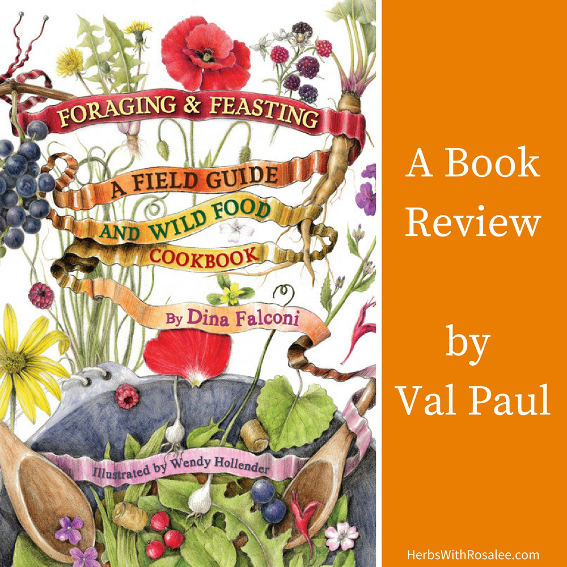Get weekly tips, recipes, and my Herbal Jumpstart e-course! Sign up for free today.

Foraging and Feasting Book Review
Share this! |
|
Foraging & Feasting: A Field Guide and Wild Food Cookbook by Dina Falconi, illustrated by Wendy Hollender
www.botanicalartspress.com
A Book Review by Val Paul
“Foraging and cooking empower me.”
The first sentence I saw upon opening Foraging & Feasting was the above quote. It struck me because I feel the same way. As I made my way through the book, it became clear that Dina Falconi’s engaging text and clear instructions combined with Wendy Hollender’s beautiful and realistic illustrations empower the reader by sharing the tools needed to confidently identify, forage, and enjoy plants themselves while honoring nature and its resources.
The Art of Foraging
Foraging & Feasting begins with Falconi sharing the importance of conscious harvesting—for the eco-system and our own food security. Dina then goes on to share regenerative harvesting tips for different plant parts (from seed to root) with illustrations on the side bar showing exactly what is meant by certain parts of the plant, such as tender leaves and stems; plant issues like overcrowding; and different types of plants, like annuals and runners, and also how to harvest invasives to control their spread. The important question regarding the safety of harvesting in certain areas is also answered.
The Plant Identification Pages: Plant Maps
I am utterly impressed with the beautifully detailed illustrations of the 50 plants included in Foraging & Feasting. I own many field guides and wildcrafting books and few - including those with photographs - convey so many important characteristics for identification as well as these illustrations do; and not surprisingly, since these visual pages are a collaboration of Dina (art director/designer) and Wendy (illustrator). Identification characteristics are described in everyday language with botanical terminology included in parentheses, making this friendly for all experience levels.
Information for each plant includes common name, Latin binomial, plant family, habitat, life cycle, reproduction, size, culinary uses, qualities, and page number reference for the recipes in the book. Some illustrations may also have one or more colored circles—there are three: red, yellow, and green—that offer further information about plants where applicable. The red circle signifies concerns and/or dangers of which to be aware. The yellow circle speaks to similarly used species or variations. The green circle refers to harvest and edibility information.
The plant maps are followed by color-coded plant charts—plant biographies, habitats/growing conditions, seasonal harvest, and culinary uses—which make for quick and easy reference.
The Kitchen Arts
“When we eat foods that have been ecologically produced—wild or cultivated—and prepared with love and a commitment to our well-being, a radical and profound change happens within us that ripples out into the rest of the world”
With more than 100 recipes—each recipe not only includes a “master recipe” but many variations of the master recipe as well—Foraging & Feasting has something for everyone.
The beverage recipes include herbal essence waters, agua frescas, smoothies, spirited drinks, herbal infusion teas, and water kefir sodas.
The relishes, spreads, and condiments section has recipes for herbal butters, tapenade, pesto, salsa, cheese and bean dips, fish spread, mayonnaise, bouillon, salts, BBQ sauces, chutney, catsup, fruit coulis and syrups.
Wild salads follow with every aspect of wild salad making from harvesting time, cleaning, tearing, dressing, adding other things like flowers or fruit, and different flavor categories of plants for best combinations. There are seasonal salads, main course salads, grain salads, beans salads, and dressings.
Wild grape leaves are covered in detail with recipes for using fresh or cooked grape leaves, as well as several stuffing options, instructions on how to roll, and preserve the grape leaves too.
The soup chapter includes recipes for hot and cold soups with extra tips like how to make soup thick and creamy without using dairy.
The perfect chapter to follow soup: sandwiches! A small chapter that has fun combinations.
The Wild Eggery chapter includes recipes and many variations for omelets, frittata, gratin, and quiche.
Cooked greens are a comfort food for me so I was delighted to see the chapter on pot herbs. Dina shares her favorite wild green combinations and recipes. The recipe for creamed greens also has dairy and gluten-free variations.
Animal kingdom entrees includes herb-baked fish, cottage pie, herbed meat loaf, and braised meat in fruit sauce.
There are desserts for everyone: crisps, cookies, truffles, short cake, pie fillings with raw or baked pie crusts, ice cream, and even aspic.
The final chapter covers basic cookery, which includes recipes for staples like whole grains, beans, nuts, stocks, and vanilla.
Some of the recipes that inspired me are: Elderberry Agua Fresca, Apple Cider Water Kefir, Bouillon, Thyme Mayo, Wild Land and Sea Miso Soup, Wild Reuben, Truffles, and the Coconut Crust.
In Closing
Foraging & Feasting: A Field Guide and Wild Food Cookbook is special—content-rich, beautifully artistic, and successful as both a guide and cookbook. I highly recommend it.
If you would like to purchase Foraging & Feasting: A Field Guide and Wild Food Cookbook, you can find it at www.botanicalartspress.com

Rosalee is an herbalist and author of the bestselling book Alchemy of Herbs: Transform Everyday Ingredients Into Foods & Remedies That Healand co-author of the bestselling book Wild Remedies: How to Forage Healing Foods and Craft Your Own Herbal Medicine. She's a registered herbalist with the American Herbalist Guild and has taught thousands of students through her online courses. Read about how Rosalee went from having a terminal illness to being a bestselling author in her full story here.
